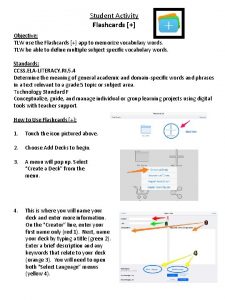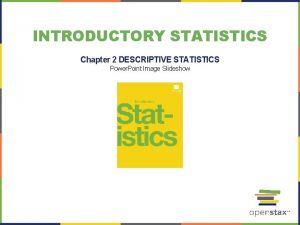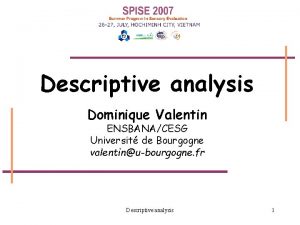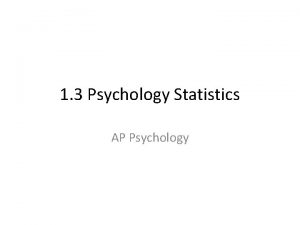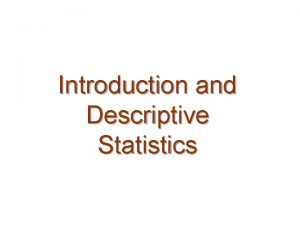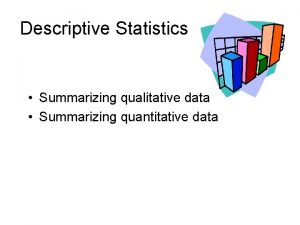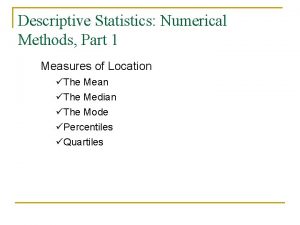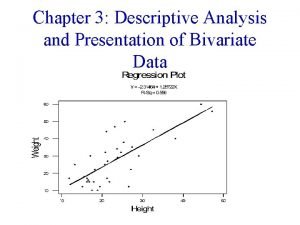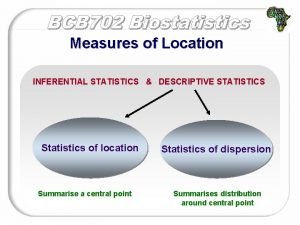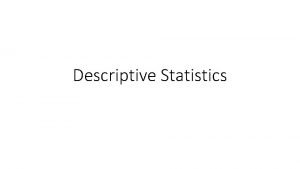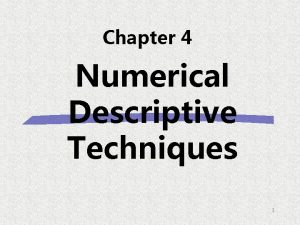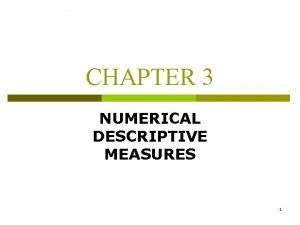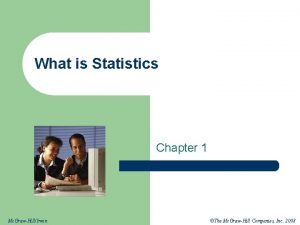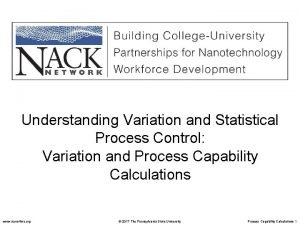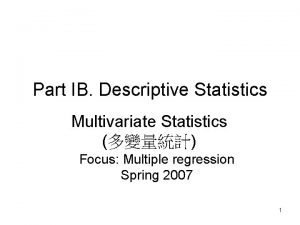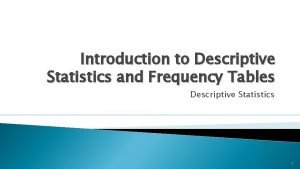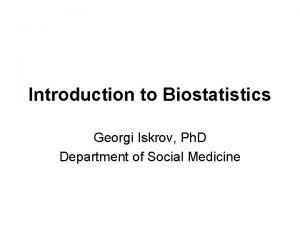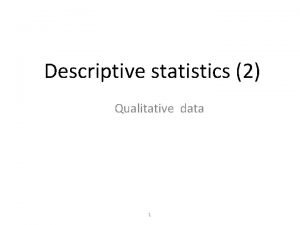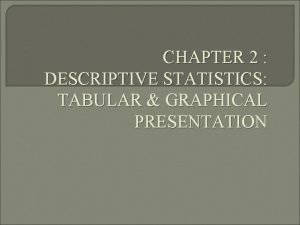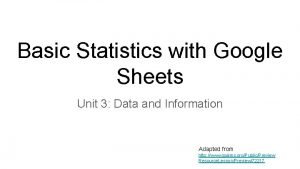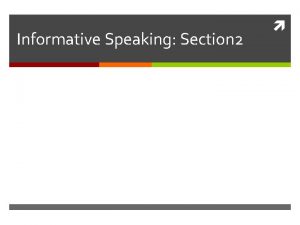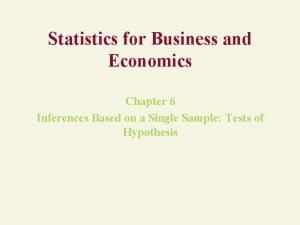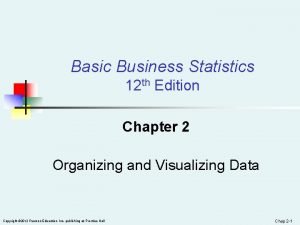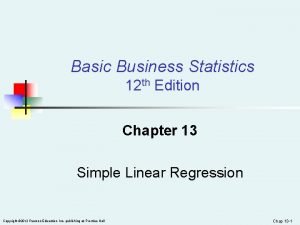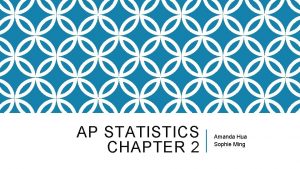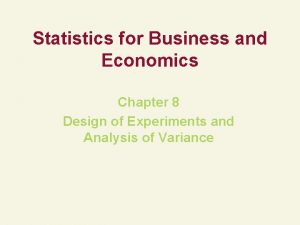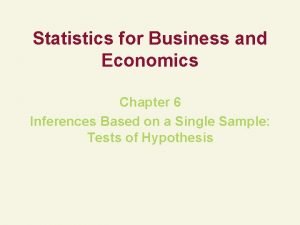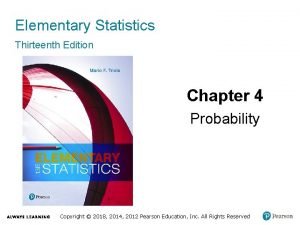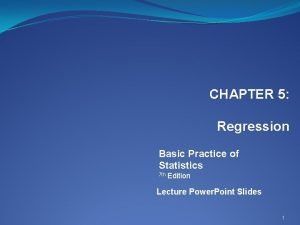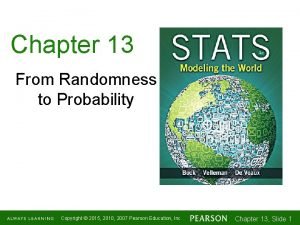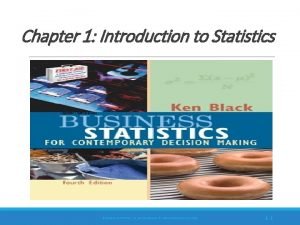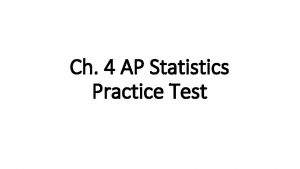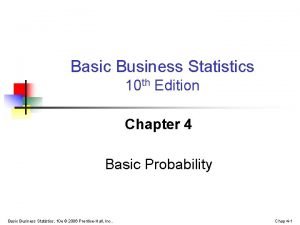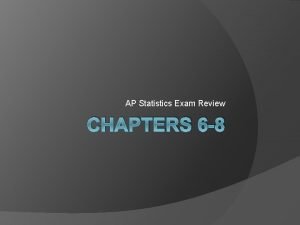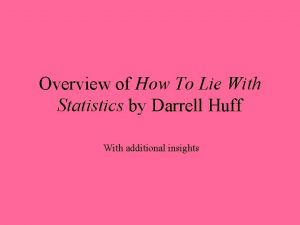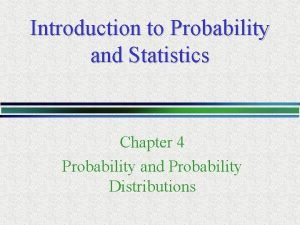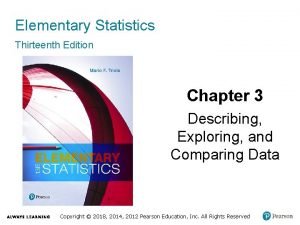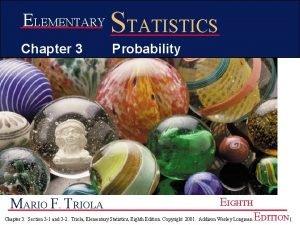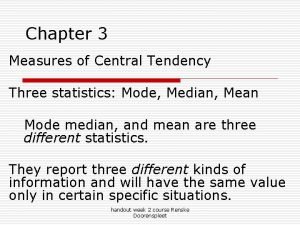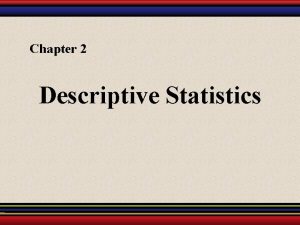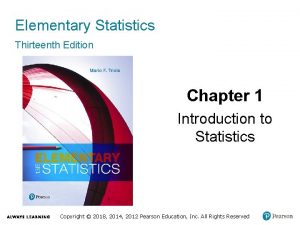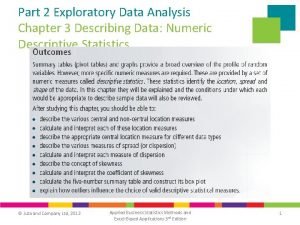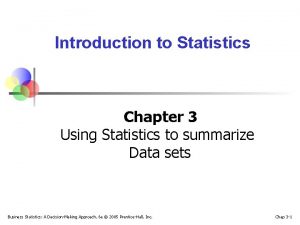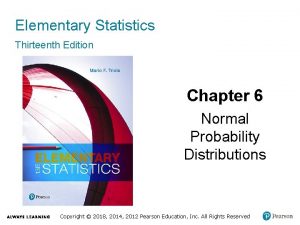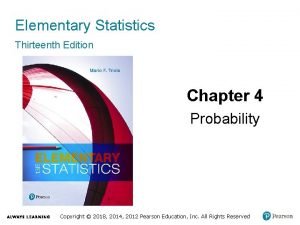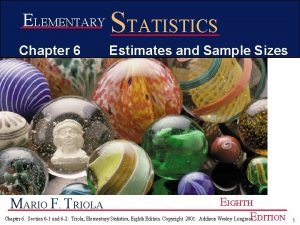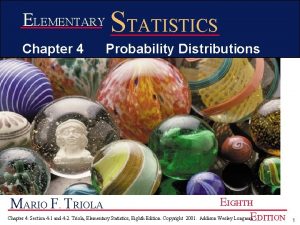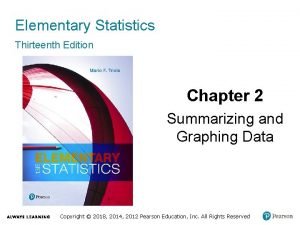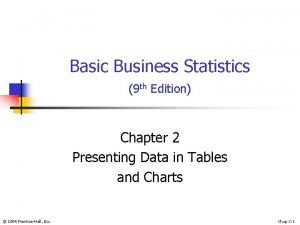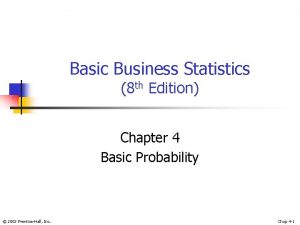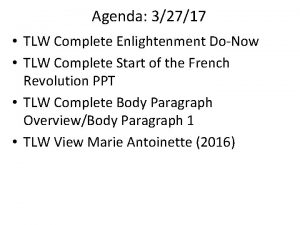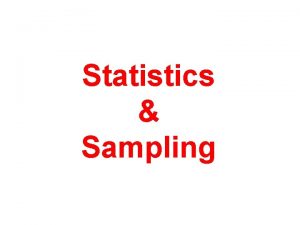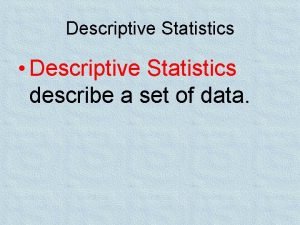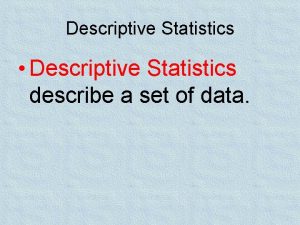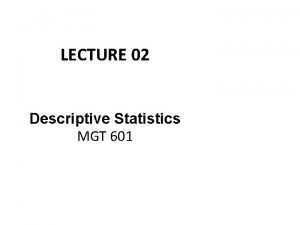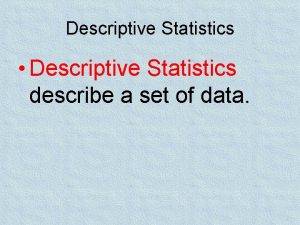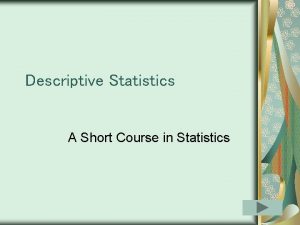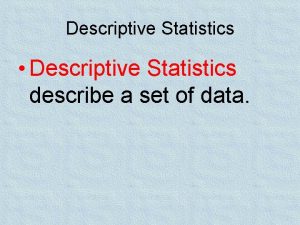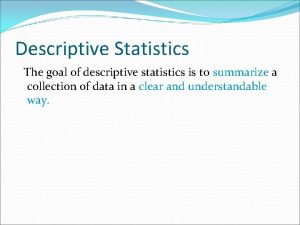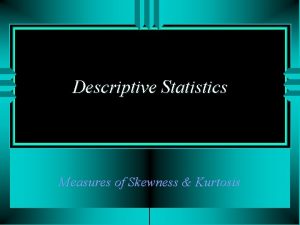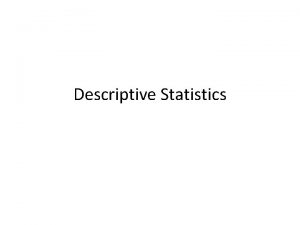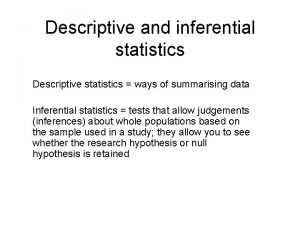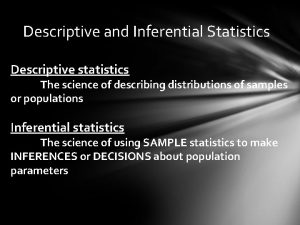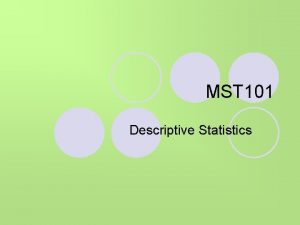Chapter 6 Descriptive Statistics 6 A TLW identify

































































- Slides: 65

Chapter 6 Descriptive Statistics 6 A: TLW identify types of data.

Vocabulary Population: defined collection about which we want to draw a conclusion Census: collect information from whole population Sample: collect information from random subset of population Survey: collection of information from a sample Data: information collected Parameter: numerical quantity measuring some aspect of a population Statistic: quantity calculated from data collected

Types of Data Categorical Variable: DESCRIBES a particular characteristics o Categories: how data is divided o Example: Computer operating systems • Windows, Mac, Linux Quantitative Variable: has a numerical value o Discrete: counting • Quantitative discrete variable • Number of apricots on a tree • Number of players in a tournament o Continuous: measuring • Quantitative continuous variable • Times taken to run a 100 m race • Heights of students in class

Example Time Classify these variables as categorical, quantitative discrete, quantitative continuous. o The number of heads when 3 coins are tossed o The brand of toothpaste used by the students in class o The heights of a group of 15 year old children

Try These P. 160 #1, 2

6 B Goal: TLW organize and display discrete data. Frequency Table: shows how many times value occurs in data set Relative Frequency: frequency as a % of data

Column Graph (Bar Graph) Quantitative discrete data Range of data = horizontal axis Frequency of data = vertical axis Column widths are equal and height represents frequency What’s the Gaps between columns– data is discrete number of peas in a pod without fertilizer 60 frequency 40 number of peas in a pod. . . 20 0 1 2 3 4 5 6 7 8 9 mode of this data?

Describing the Distribution of a Data Set Symmetry/Partial Symmetry: symmetry about the mode Symmetrical distribution: curve of columns show symmetry Negatively Skewed: curve “stretched” to the left Positively Skewed: curve “stretched” to the right

Outliers Data values either or much smaller than general body of data

Example 30 children attended a library holiday program. Their year levels at school were: 8 7 6 7 7 7 9 7 7 11 8 10 8 8 9 10 7 7 8 8 7 6 6 9 6 9 Record the information in a frequency table , including relative frequency. Construct a column graph. What is the modal year level? Describe the shape of the distribution. Are there outliers? What percentage of children were in year 8 or below? What percentage of the children were above year 9?

Assignment P. 164 #1 -5

6 C TLW interpret quantitative discrete data. Use when there are different data values with very frequencies. o Makes it hard to study data distribution o Group into class intervals and compare the frequency for each class • Modal Class– class with highest frequency. o Column Graph: for grouped discrete data in the same was as before o If we are given a set of raw data, how can we efficiently find the lowest and highest data values? o If the data values are grouped in classes on a frequency table/column graph, do we still know what the highest and lowest values are?

p. 166 #1 Arthur catches the train to school from a busy train station. Over the course of 30 days he counts the number of people waiting at the station when the train arrives. 17 25 32 19 45 30 22 15 28 8 21 29 37 25 42 35 19 31 26 7 22 11 27 44 24 22 32 18 40 29 Construct a tally and frequency table for this data using class intervals 0 -9, 10 -19, …, 40 -49. On how many days were there less than 10 people at the station? On what percentage of days were there at least 30 people at the station? Draw a column graph to display the data. Find the modal class of the data.

Your Turn p. 166 #2 -3

6 D: TLW identify and apply quantitative continuous data. Continuous: cannot write down exact values o Heights of students o Time it takes to run a race Class intervals: group data because no two data values will be exactly the same. Frequency Histograms: displays grouped continuous data o Like a bar graph but columns joined! o Edges of columns show the boundaries of class intervals discrete continuous

Other Stuff

Example A sample of 20 juvenile lobsters was randomly selected from a tank containing several hundred. The length of each lobster was measured in cm, and the results were: o o 4. 9 5. 6 7. 2 6. 7 3. 1 4. 6 6. 0 5. 0 3. 7 7. 3 6. 0 5. 4 4. 2 6. 6 4. 7 5. 8 4. 4 3. 6 4. 2 5. 4 Organize the data using a frequency table, and hence graph the data. Length (l cm) Tally Frequenc y

Assignment P. 168 #1 -6

6 E TLW find measures of central tendency and interpret them.

Formula for Mean

Median

Example Find the mean, mode and median: o 3, 6, 5, 6, 4, 5, 5, 6, 7 o 13, 12, 15, 13, 18, 14, 16, 15, 17

Using Your GDC A teenager recorded the time (in minutes per day) he spent playing computer games over a 2 week holiday period: 121, 65, 45, 130, 150, 83, 148, 127, 20, 173, 56, 49, 104, 97 Using technology, determine the mean and median daily game time the teenager recorded.

Assignment P. 172 # 1, 2, 4, 6, 8 -17 o Use your GDC to help!!!

Effects of Outliers 1. Outliers: extreme values, much greater than or much less than the other values. Consider the set of data: 4, 5, 6, 6, 6, 7, 7, 8, 9, 10. Calculate: a. mean b. mode c. median We now introduce the extreme value of 100 to the data, so that the data set is now: 4, 5, 6, 6, 6, 7, 7, 8, 9, 100 Calculate: a. mean b. mode c. median 1. Comment on the effect that the extreme value has on: 2. Which of the three measures of central tendency is most affected by the inclusion of an outlier. 3. When is it not appropriate to use a particular measure of the center of a data set? 2.

Choosing the Appropriate Measure Mode: gives the most usual value o Only takes common values into account o Not affected by extreme values Mean: commonly used & easy to understand o Takes all value into account o Affected by extreme values Median: gives halfway point o Only takes middle values into account o Not affected by extreme values

Examples A shoe store is investigating the sizes of shoes sold over one month. The mean shoe size is not very useful to know, but the mode shows at a glance which size the store most commonly has to restock. On a particular day a computer shop makes sales of $900, $1250, $1000, $1700, $1140, $1100, mean is $1200. The mean is the best measure of center as the salesman can use it to predict average profit. When looking at real estate prices, the mean is distorted by the few sales of very expensive houses. For a typical house buyer, the median will best indicate the price they should expect to pay in a particular area.

Measure of the Center From Other Sources Find the mode, mean and median from the table. Data value (x) Frequenc y (f) Product (fx) 3 1 1*3=3 4 1 1*4=4 5 3 3*5=15 6 7 7*6=42 7 15 15*7=105 8 8 8*8=64 9 5 5*9=45 Total

Example The table shows the number of aces served by tennis players in their first sets of a tournament. Determine the: mean, median, mode for this data. Number of aces (x) Frequency (f) 1 4 2 11 3 18 4 13 5 7 6 2 Product (fx) Cummulativ e Frequency

Example with the GDC Find the mean and median with the GDC. Number of aces (x) Frequency (f) 1 4 2 11 3 18 4 13 5 7 6 2

Assignment P. 178 #1 -5

Data in Classes Information is grouped in classes Use the midpoint or mid-interval value to represent values in the interval Assumption: values are evenly distributed throughout interval Mean is an approximation of the true value

Mid-Interval Values What effect will using mid-interval values representing all scores in an interval have on estimating the mean of the grouped data. Calculate the mean using the highest possible results. Calculate the mean of the results using the lowest possible results. Calculate the mean using the midinterval values. How do they compare? Marks Frequency 0 -9 2 10 -19 31 20 -29 73 30 -39 85 40 -49 28

Example Estimate the mean of the following ages of bus drivers data, to the nearest year. Age Frequency 21 -25 11 26 -30 14 31 -35 32 36 -40 27 41 -45 29 46 -50 17 51 -55 7 Midpoint fx

Assignment P. 181 #1 -6

6 F: TLW measure the spread of data. To accurately describe distribution, you need to know the center and how the data spreads out. The A distribution has most scores around the mean The C distribution has the greatest spread.

Measurements Range: largest – smallest o Not particularly reliable measurement of spread; only uses two data points o A library surveys 20 borrowers each day from Monday to Friday, and records the number who are not satisfied with the range of reading material. The results are: 3 7 6 8 11. o The following year the library receives a grant that enables the purchase of a large number of books. The survey is then repeated and the results are: 2 3 5 4 6. o Find the range of data in each survey.

Quartiles and the Interquartile Range (IQR)

Example For the data set: 7, 3, 1, 7, 6, 9, 3, 8, 5, 8, 6, 3, 7, 1, 9 Find the median Find the lower quartile Find the upper quartile Find the IQR

Example

Data and the GDC Consider the data set: 20, 31, 4, 17, 26, 9, 29, 37, 13, 42, 20, 18, 25, 7, 14, 3, 23, 16, 29 Find the Range and IQR with your GDC.

Assignment P. 184 #1 -2 without the GDC P. 185 #3 -4 with the GDC

6 G: TLW create a box-and-whisker plot and interpret it. Five-Number Summary 1. Minimum 2. Lower quartile 3. Median 4. Upper quartile 5. Maximum **All are shown on a Box and Whisker

Box and Whisker Box = middle half of data Lower whisker = 25% of data with smallest values Upper whisker = 25% of data with greatest values.

Interpreting a Boxplot Symmetric distribution Whiskers of boxplot Are the same length And the median line is In the center of box Positively skewed Negatively skewed Right whisker is longer Left whisker is longer than left whisker than the right whisker and the median line is to the left of the box is to the right of the box

Example Consider the data set: 8, 2, 3, 9, 6, 5, 3, 2, 6, 2, 5, 4, 5, 6 o Construct the five-number summary for this data. o Draw a boxplot o Find the range and IQR o Find the percentage of data values less than 3.

Assignment P. 188 #1 -5

Parallel Boxplots Compares two data sets Example: A hospital is trialling a new anesthetic drug and has collected data on how long the new and old drugs take before the patient becomes unconscious. They wish to know which drug acts faster and which is more reliable. o Old drug times: 8, 12, 9, 8, 16, 10, 14, 7, 5, 21 13, 10, 8, 10, 11, 8, 1, 9, 11, 14 New drug times: 8, 12, 7, 8, 12, 11, 9, 8, 10, 9, 12, 8, 7, 10, 7, 9 Prepare a parallel boxplot for the data sets and use it to compare the two drugs for speed and reliability.

Assignment P. 190 #1 -5 odds

Outliers

Example Test the following data for outliers and hence construct a boxplot for the data: 3, 7, 8, 5, 9, 10, 12, 14, 7, 1, 3, 8, 16, 8, 6, 9, 10, 13, 7

Assignment P. 192 #1 and 2

6 H TLW create and interpret cumulative frequency graphs.

Examp le The data shows the result of the women’s marathon at the 2008 Olympics, for all competitors who finished the race. o o o Construct a cumulative frequency distribution table Represent the data on a cumulative frequency graph Use your graph to estimate the • Median finishing time • Number of competitors who finished in less than 2 hours 35 minutes • Percentage of competitors who took more than 2 hours 39 minutes to finish • Time taken by a competitor who finished in the top 20% of runners completing the marathon. Finishing time Frequenc t y 2 h 26 ≤ t < 2 h 28 8 2 h 28 ≤ t < 2 h 30 3 2 h 30 ≤ t < 2 h 32 9 2 h 32 ≤ t < 2 h 34 11 2 h 34 ≤ t < 2 h 36 12 2 h 36 ≤ t < 2 h 38 7 2 h 38 ≤ t < 2 h 40 5 2 h 40 ≤ t < 2 h 48 8 2 h 48 ≤ t < 2 h 56 6 Cumulativ e Frequency

Finishing time Frequenc t y 2 h 26 ≤ t < 2 h 28 8 2 h 28 ≤ t < 2 h 30 3 2 h 30 ≤ t < 2 h 32 9 2 h 32 ≤ t < 2 h 34 11 2 h 34 ≤ t < 2 h 36 12 2 h 36 ≤ t < 2 h 38 7 2 h 38 ≤ t < 2 h 40 5 2 h 40 ≤ t < 2 h 48 8 2 h 48 ≤ t < 2 h 56 6 Cumulativ e Frequency Another way to calculate percentiles is to add a separate scale to a cumulative frequency graph. Putting corresponding right side of graph.

Assignment P. 195 # 1 -7 odd

6 I TLW find standard deviation and interpret.

Standard Deviation Non-resistant measure of spread Only useful if distribution close to symmetrical IQR/percentiles more appropriate if spread is considerably skewed.

Standard Deviation without GDC Calculate the standard deviation of the data set: 2, 5, 4, 6, 7, 5, 6 Score (x) 2 4 5 5 6 6 7 35

Try it with GDC Calculate the standard deviation of the data set: 2, 5, 4, 6, 7, 5, 6 Assignment: p. 199 #1 -6

Standard Deviation for Grouped Data Only for continuous data or data grouped in classes Use mid-interval values to represent data for an interval

Example Use technology to estimate the standard deviation for this distribution of examination scores: Mark Midinterval Frequency 0 -9 1 10 -19 1 20 -29 2 30 -39 4 40 -49 11 50 -59 16 60 -69 24 70 -79 13 80 -89 6 90 -99 2

Assignment P. 201 #1 -7

More 6 I TLW compare the spread of two data sets. Look at the mean of 2 data sets and compare Also use their standard deviation to compare the spread The following exam results were recorded by two classes of students studying Spanish. Use the GDC. o o Class A: 64, 69, 74, 67, 78, 88, 76, 90, 89, 84, 83, 87, 78, 80, 95, 75, 55, 78, 81 Class B: 94, 90, 88, 81, 86, 92, 93, 88, 72, 94, 61, 87, 90, 97, 95, 77, 82, 90

Assignment P. 203 #1 -4
 Tlw meaning school
Tlw meaning school Chapter 2 descriptive statistics answer key
Chapter 2 descriptive statistics answer key What is the value of σx2 for the scores 1, 0, 2, 4?
What is the value of σx2 for the scores 1, 0, 2, 4? Difference between descriptive and inferential statistics
Difference between descriptive and inferential statistics Example of descriptive statistics
Example of descriptive statistics Descriptive statistics ap psychology
Descriptive statistics ap psychology Introduction to descriptive statistics
Introduction to descriptive statistics How to summarize qualitative data
How to summarize qualitative data Numerical descriptive statistics
Numerical descriptive statistics Descriptive statistics numerical measures
Descriptive statistics numerical measures Bivariate descriptive statistics
Bivariate descriptive statistics Measures of location
Measures of location Types of descriptive statistics
Types of descriptive statistics Jack in box
Jack in box Variance and standard deviation formula
Variance and standard deviation formula Inferential statistics definition
Inferential statistics definition Data pensylvania1
Data pensylvania1 Definition of descriptive statistics
Definition of descriptive statistics Multivariate descriptive statistics
Multivariate descriptive statistics Descriptive statistics frequency distribution
Descriptive statistics frequency distribution Descriptive statistics
Descriptive statistics Descriptive statistics classification
Descriptive statistics classification Tabular presentation of qualitative data
Tabular presentation of qualitative data Descriptive statistics in google sheets
Descriptive statistics in google sheets Introduction to statistics what is statistics
Introduction to statistics what is statistics Identify the descriptive speech.
Identify the descriptive speech. Population proportion
Population proportion Ap statistics chapter 27 quiz
Ap statistics chapter 27 quiz Dcova method
Dcova method Chapter 13 statistics
Chapter 13 statistics Ap statistics chapter 7 multiple choice test answers
Ap statistics chapter 7 multiple choice test answers Amanda hua
Amanda hua Block design example
Block design example When to use z test and t test
When to use z test and t test Elementary statistics chapter 4
Elementary statistics chapter 4 The practice of statistics chapter 5
The practice of statistics chapter 5 Ap statistics chapter 13 from randomness to probability
Ap statistics chapter 13 from randomness to probability Chapter 1 introduction to statistics
Chapter 1 introduction to statistics Ap stats practice exam multiple choice
Ap stats practice exam multiple choice Business statistics chapter 4
Business statistics chapter 4 Ap stats ch 6 review
Ap stats ch 6 review Ap statistics chapter 3
Ap statistics chapter 3 How to lie with statistics chapter 1 summary
How to lie with statistics chapter 1 summary Probability and statistics chapter 3 test answer key
Probability and statistics chapter 3 test answer key Chapter 4 probability
Chapter 4 probability Elementary statistics chapter 3
Elementary statistics chapter 3 Elementary statistics chapter 3
Elementary statistics chapter 3 Statistics chapter 3 measures of central tendency
Statistics chapter 3 measures of central tendency Elementary statistics larson farber
Elementary statistics larson farber Chapter 1 introduction to statistics
Chapter 1 introduction to statistics Elementary statistics 13th edition chapter 1
Elementary statistics 13th edition chapter 1 Chapter 1 the nature of probability and statistics
Chapter 1 the nature of probability and statistics Jeopardy statistics
Jeopardy statistics Business statistics i com part 2 chapter 3
Business statistics i com part 2 chapter 3 Introduction to statistics chapter 3 answers
Introduction to statistics chapter 3 answers Elementary statistics chapter 6
Elementary statistics chapter 6 Elementary statistics chapter 4
Elementary statistics chapter 4 Margin of error adalah
Margin of error adalah Elementary statistics chapter 4
Elementary statistics chapter 4 Elementary statistics chapter 2
Elementary statistics chapter 2 Ap statistics chapter 17
Ap statistics chapter 17 Business statistics chapter 2
Business statistics chapter 2 Business statistics chapter 4
Business statistics chapter 4 Identify and meet a market need
Identify and meet a market need Finer criteria for research questions
Finer criteria for research questions Example of descriptive paragraph
Example of descriptive paragraph
